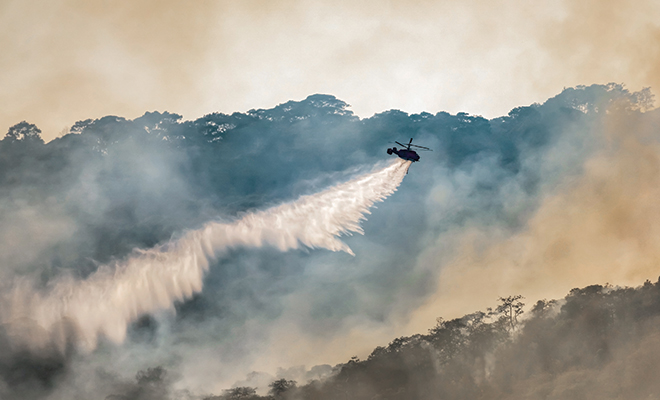
The Amazon is Still on Fire
In August 2019, smoke from a record number of wildfires raging through the Amazon rainforest darkened the daytime skies over São Paulo. The Amazon region is often called the lungs of the planet because it produces so much oxygen from carbon dioxide, prompting international concern about the fire situation.
Public outrage over poor air quality eventually forced the Brazilian government to deploy military troops as firefighters. Even so, more than 2.5 million acres of forest had burned by year’s end. Using satellite data, scientists estimated an 80 percent increase in fires over the previous year.
Massive fires don’t typically occur in tropical rainforests. According to observers, most of the recent fires were started on purpose in recently deforested areas. Cattle ranchers and farmers who are clearing forestland typically wait until felled trees have dried out and then burn them. Brazil enacted environmental regulations in 2004 to slow the deforestation process, but enforcement had decreased in recent years. Studies show that about 85 percent of the 2019 fires in Brazil occurred in recently deforested areas.
Why should we all care about Amazon fires? The rainforest plays a major role in the earth’s climate by removing greenhouse gases from the atmosphere. If the area becomes so decimated that it can no longer perform that function, the ensuing release of carbon currently stored in trees could lead to a climate change catastrophe. Another reason we should care is that the Amazon is home to 10 percent of the world’s animal species. Both plants and animals are severely affected by forest fires. Since fire doesn’t occur naturally in the rainforest environment, they are mostly unable to adapt.
The fires also impact the Amazon’s native people. Indigenous groups who lose land to fire lose access to rivers, plants and animals traditionally used for food, clothing and shelter. Many indigenous groups in Brazil have had to fight fires in their homelands with little government support. Smoke from fires poses a health risk for everyone living in the rainforest, but indigenous tribes can be more seriously affected because their isolation gives them little immunity to disease. Respiratory illnesses can be devastating to isolated settlements.
The wet season of 2019 unfortunately did not bring a permanent end to Amazon fires. Satellite data obtained by NASA indicates that fire activity increased again in 2020. Fires set to clear land for ranching and farming in deforested areas increased by 23 percent compared to 2019. There was also a 60 percent increase in so-called understory fires within the rainforest, usually started by out-of-control human-set fires on adjacent deforested land.
Why have Amazon fires suddenly gotten worse? Since taking office in 2019, Brazil’s President Jair Bolsonaro has openly supported legal development of Amazon land, including indigenous territories. Many also blame him for allowing illegal deforestation to flourish. His actions have affected millions of people who have been exposed to harmful smoke dense with pollutants linked to respiratory and cardiovascular diseases. Even before the COVID pandemic, there were increased hospitalizations in the region for people affected by fires. At highest risk are children, elderly people and people who are pregnant or who have pre-existing lung or heart issues.
The effects of smoke can be seen and felt, but it’s still too early to fully understand the environmental impact of heightened levels of CO2 that have already been measured while Amazon fires are burning. Unfortunately, President Bolsonaro has chosen to downplay the crisis, denying that fires continued after he declared a moratorium on deforestation during Brazil’s dry season. Meanwhile, the world is watching and hoping his government will take steps to protect the Amazon rainforest and its inhabitants before it’s too late.
According to researchers at Purdue University, more fires in the Amazon region could bring major changes to the landscape, with savannas or grasslands replacing rainforest. Scientists have warned that these changes will eventually bring about an Amazon tipping point, with the environment becoming so dry it no longer is effective at capturing carbon. Once the tipping point is reached, the loss of the Amazon’s carbon storage will be felt around the globe in the form of changes in temperature, rainfall and other weather events. In addition, many plant and animal species could be pushed to extinction by the change.
The Amazon tipping point is defined by many as the loss of between 20 and 25 percent of the rainforest, and the World Wildlife Fund estimates that around 17 percent has been lost since 1950. If you want to help save the Amazon, consider eating less beef imported from Brazil. The majority of deforested land in the Amazon is used for cattle ranching. ■
Sources: greenpeace.org, hrw.org, nationalgeographic.com and purdue.edu.







